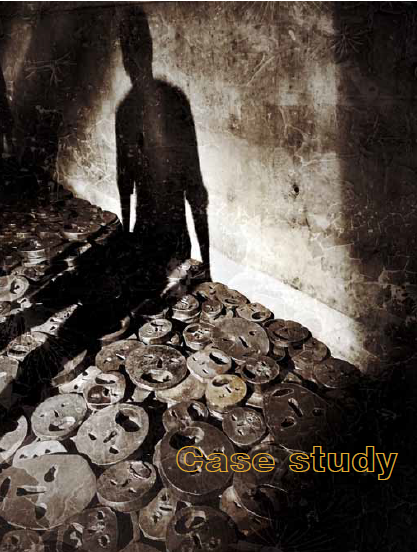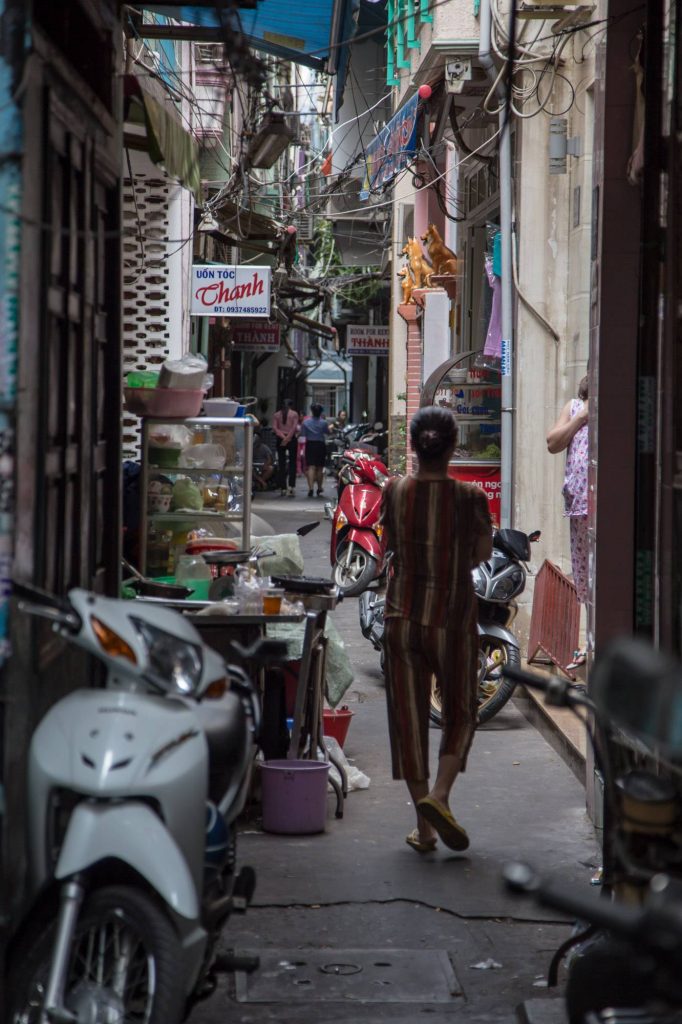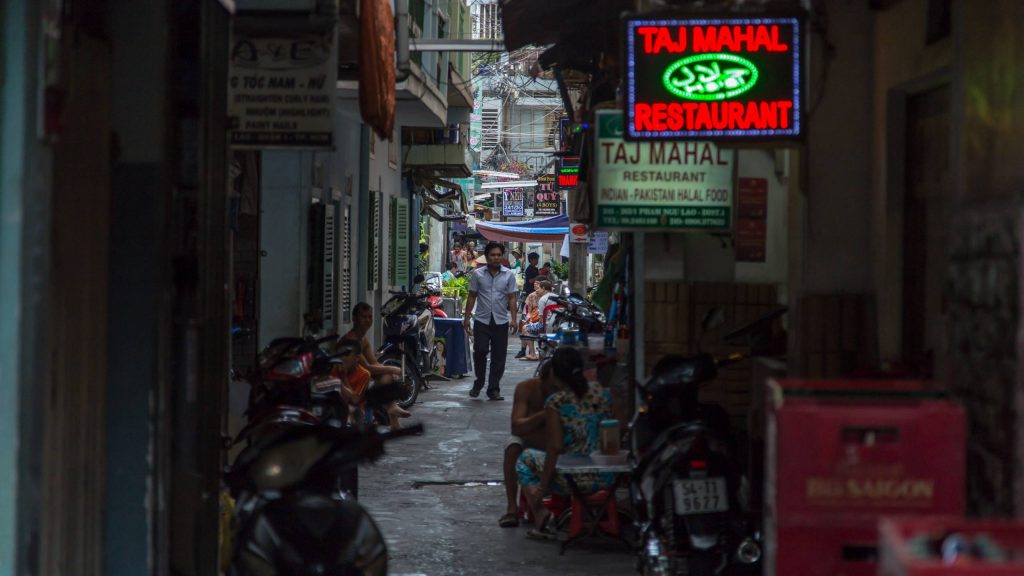[S01.5] Non-religious Spiritual space for social cohesion in Vietnam

4.2.2 The laneway (con hẻm) in the Vietnam urban areas.
Since the end of the nineteenth century, the role of the village has become less and less important in the social structure, the massive population movement from village to city during and after wartime has placed a huge burden on the housing issue in urban cities. For this cause, public space has been subdued to the secondary concern in urban planning. Consequently, changing use of social space among urbanites has been recorded in the shape of the space “between” within the busy residential area such as laneway (hẻm) (Earl 2010). The flexibility in its function, shifting from public to private, from day to night delineate its “informal” quality.
Laneway is a narrow space or a connecting pathway in some cases between two buildings which is usually utilized as a platform for small family businesses and neighbourhood gathering. It is public in regard to openness but private in the use of the inhabitants. Despite the limited dimensions, this is the place where news and gossip are spread out as well as socializing activities are taken place in a variety of levels and forms. It is said that the image of each laneway can reflect the character of each neighbourhood to a certain extent, giving a glimpse at the daily life of the urbanites.


In general, the informal social space encouraged the social interaction and communication between independent individuals beyond the state control or suppression within the social frame. Hence, the structure of collective memory built up from such spaces is bottom-up, reflect both individual and communal quality within a social setting. It also explains the main drive of collective memory in Vietnamese society stemmed from a personal desire to be inclusive in their own community (village or neighbourhood) and this string gives them a strong sense of belonging.
Reference:
Bevan, R. (2006) The destruction of memory- Architecture at war., London: Reaktion Books Ltd.
Bich, L. (2014) ‘Cay da 500 tuoi o ngoai thanh Ha Noi’, [online], available: https://www.phongtuc.vn/cay-da-500-tuoi-o-ngoai-thanh-ha-noi/].
Bouquet, M. (2010) ‘Vietnamese party-state and religious pluralism since 1986: Building the fatherland?’, Journal of Social Issues in Southeast Asia, 25(1), 90.
Caan, S. (2011) Rethinking design and interiors: human beings in the built environment, London: Laurence King.
Can, B. (2017) ‘Architecture and the Social Frameworks of Memory: A Postscript to Maurice Halbwachs’ “Collective Memory”‘, Iconarp International Journal of Architecture and Planning, 5(1), 01-09.
Coles, J. and House, N. (2007) The fundamentals of Interior Architecture, United Kingdom: AVA Publishing SA.
Duiker, W. J. (1995) Vietnam : Revolution in transition, 2nd edition ed., America: Westview Press.
Earl, C. (2010) ‘Vietnam’s “Informal Public” Spaces: Belonging and Social Distance in Post-reform Ho Chí Minh City’, Journal of Vietnamese Studies, 5(1), 86-124.
Fathy, H. (1973) Architecture for the Poor: An experiment in rural Egypt, Chicago- London: The University of Chicago.
Frampton, K. (1992) Modern architecture: a critical history / by Kenneth Frampton, 3rd ed. ed., United Kingdom: Thames & Hudson.
Hickey, G. C. (1967) Village in Vietnam, 4th edition ed., New Haven and London: Yale University Press.
Juhani, P. (2005) The Eyes of the skin- Architecture and the sense, Great Britain: John Wiley & Son.
Libeskind, S. ‘Jewish Museum Berlin‘, [online], available: https://libeskind.com/work/jewish-museum-berlin/].
Lien, Q. (2011) ‘Cay da lang‘, [online], available: http://baothaibinh.com.vn/tin-tuc/19/5972/cay-da-lang].
Marr, D. G. (1984) Vietnamese tradition on trait, 1920-1945, London: University of California Press.
McCarter, R. (2016) The space within- Interior Experiences as the origin of architecture, London: Reaktion Books Ltd.
McLeod, M. W. (2001) Culture and customs of Vietnam, Westport, Conn. ; London: Greenwood Press.
Meusburger, P., Heffernan, M. and Wunder, E. (2011) Cultural Memories: The Geographical points of view, Knowledge and Space, Netherlands: Springer Netherlands.
Nesbitt (1996) Theorizing a new agenda for architecture : an anthology of architectural theory 1965-1995 / edited by Kate Nesbitt, Princeton Architectural P.
Nguyen, C. X. (2015) ‘Mot goc cua Ha Noi “thanh lich” nam 2015‘, [online], available: http://chauxuannguyen.org/2015/10/18/mot-goc-cua-ha-noi-thanh-lich-nam-2015/].
Nguyễn, V. n. H. and Kendall, L. (2003) Vietnam : journeys of body, mind, and spirit, America, London: The University of California Press.
Nisbett, R. E. (2003) The geography of thought : how Asians and Westerners think differently … and why, London: Nicholas Brealey.
Nuttgens, P. (1983) The story of architecture, Great Britain: Butler& Tanner Ltd.
Reeh, H. (2016) ‘Encountering empty architecture : Libeskind’s Jewish Museum Berlin‘, Journal of Art Historiography.
Robinson, J. W. (2006) Institution and home: Architecture as a cultural medium, The Netherlands: Techne Press.
Sabelli, H. (1998) ‘The union of opposites: from Taoism to process theory’, Systems Research and Behavioral Science, 15(5), 429-441.
Solheim, W. (1971) ‘New light on a forgotten past’, National Geographic, 139(3), 330.
teamLab (2018) ‘The way of the sea in the memory of Topography-Colours of life’, [online], available: https://www.teamlab.art/w/sea_topography/].
Templer, R. (1999) Shadows and wind: a view of modern Vietnam, New York: The Penguin Group.
Thuy, T. ‘Gia tri van hoa gieng lang‘, [online], available: http://disanlangviet.com/2109-2/].
Tran, N. T. (1996) Tim ve ban sac van hoa Viet Nam, Vietnam: Ho Chi Minh city Press.
Vinnitskaya, I. (2012) ‘Ground Zero Master plan- Studio Daniel Libeskind‘, [online], available: https://www.archdaily.com/272280/ground-zero-master-plan-studio-daniel-libeskind].
Wright, S. (2015) ‘Streets and Laneways of Ho Chi Minh city‘, [online], available: https://www.regularsteven.com/streets-and-laneways-of-ho-chi-minh-city/].
